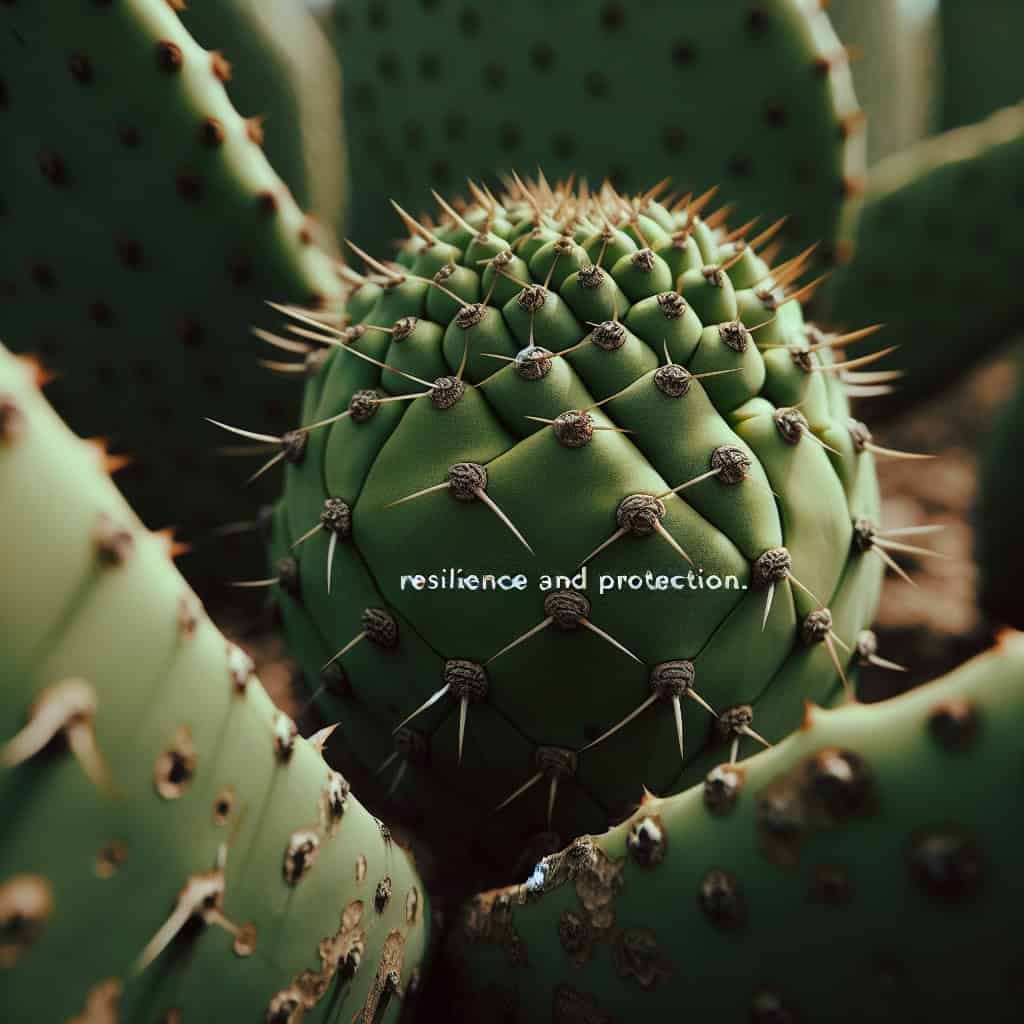If you’re a proud owner of nopal, also known as prickly pear cactus, you might have found yourself wondering how to shield this resilient plant from the unpredictable wrath of strong winds and stormy weather. Nopal’s vibrant green pads and vibrant fruits can withstand many challenges, but when the gusts start to howl and the rain pours down, it’s important to take steps to safeguard its well-being. In this article, we will explore some effective measures you can take to protect your nopal from these formidable forces of nature, ensuring it continues to thrive and beautify your space. So, let’s dive right in and discover how to keep your nopal safe and sound during turbulent weather conditions.
Choosing the Right Location
When it comes to growing nopal plants, choosing the right location is crucial for their success and survival. One important consideration in selecting the location is the wind patterns in the area. Nopal plants are susceptible to wind damage, especially during strong winds and storms. Therefore, it is essential to find a location that is sheltered from strong gusts.
Considering Wind Patterns
To choose the right location for your nopal plants, it’s important to consider the prevailing wind patterns in your area. Understanding the direction and intensity of the wind can help you determine the best spot for your plants. If possible, choose a location that is shielded from strong winds. This can be achieved by placing your nopal plants close to a building, fence, or a natural windbreak such as a hill or a row of trees.
Avoiding Exposed Areas
Avoid planting your nopal in exposed areas where strong winds can easily reach your plants. Exposed areas, such as hilltops or open fields, can subject your nopal plants to constant and damaging winds. These winds can cause stress, breakage, and even uprooting of the plants. Instead, opt for a location that provides some level of protection, especially during storms or windy periods.
Preparing Nopal Plants
To ensure the resilience and health of your nopal plants, proper preparation is essential. This involves several tasks, including trimming excess growth, pruning diseased or weak pads, and staking the plants for stability.
Trimming Excess Growth
Before storms or strong winds approach, it is advisable to trim any excess growth from your nopal plants. This includes removing any weak or overgrown pads. By doing so, you can eliminate potential weak spots that could easily break or become damaged during high winds. Pruning excess growth also allows your plants to direct their energy and resources towards healthy growth and strengthening.
Pruning Diseased or Weak Pads
Inspect your nopal plants regularly and remove any diseased or weak pads. Diseased pads are not only prone to damage during storms but can also spread diseases to other healthy portions of the plant. Pruning these pads will not only promote the overall health of your nopal but also reduce the risk of damage from strong winds.
Staking the Plants
Staking your nopal plants provides additional support and stability, especially during storms or high winds. This can be done by pushing stakes into the ground and then gently tying the plant to the stakes using soft ties or plant ties. Staking helps prevent the plants from bending, breaking, or being uprooted by strong gusts. Make sure the stakes are securely anchored in the ground to provide optimal support.

Creating Windbreaks
Windbreaks are structures or plantings that help protect your nopal plants from strong winds. They act as barriers, reducing the force and impact of the wind on your plants. There are several options for creating windbreaks, including using fences or walls, planting wind-resistant shrubs or trees, or utilizing synthetic windbreaks.
Using Fences or Walls
Installing a fence or a wall around your nopal plants can provide effective wind protection. Solid fences, such as wooden or metal ones, create a physical barrier that interrupts and redirects the wind around your plants. On the other hand, walls made from stone or concrete can also serve as windbreaks, reducing the wind’s impact and protecting your nopal plants. Ensure that the height of the fence or wall is sufficient to create a noticeable wind reduction.
Planting Wind-resistant Shrubs or Trees
Another option for creating windbreaks is to plant wind-resistant shrubs or trees around your nopal plants. These plants act as natural barriers, helping to divert and reduce the strength of the wind. Look for species that are known for their wind resistance, such as junipers, arborvitae, or holly. Plant them strategically to form a windbreak around your nopal plants, providing them with much-needed protection.
Using Synthetic Windbreaks
If natural windbreak options are limited in your area, consider using synthetic windbreaks. These include materials like shade cloth, windbreak netting, or windbreak fencing. Synthetic windbreaks can be conveniently installed and offer efficient protection against strong winds. They can be positioned strategically to shield your nopal plants from direct wind, reducing the risk of damage or uprooting.
Protecting Nopal Pads
During storms or heavy winds, the pads of your nopal plants are particularly vulnerable to damage. To minimize the risk, there are various methods you can employ to protect the pads, including covering them with burlap or fabric, utilizing protective coatings, and using temporary shelters.
Covering with Burlap or Fabric
One way to protect nopal pads from strong winds and storms is by covering them with burlap or fabric. This acts as a shield against the harsh elements, preventing wind from directly hitting the pads. Secure the fabric or burlap over the plants using stakes or clips. This method provides an additional layer of insulation and protection, reducing the risk of the pads being torn or damaged.
Utilizing Protective Coatings
Applying protective coatings, such as an anti-transpirant spray, can help safeguard the nopal pads from strong winds. These sprays create a thin, protective film on the surface of the pads, reducing moisture loss and increasing resistance to wind damage. Follow the manufacturer’s instructions when applying the protective coating, ensuring thorough coverage of the pads.
Using Temporary Shelters
In extreme cases or during severe storms, you may consider using temporary shelters to safeguard your nopal plants. This can be done by constructing simple structures made of PVC pipes or metal frames and covering them with plastic or fabric sheeting. These shelters act as a shield against the wind and heavy rain, providing a protective microclimate for your nopal plants.

Securing Plant Structures
In addition to protecting the nopal pads, it’s crucial to secure the overall structures supporting your plants. This includes anchoring greenhouses or polytunnels and reinforcing stakes or support structures.
Anchoring Greenhouses or Polytunnels
If you are growing nopal plants in a greenhouse or polytunnel, it is important to ensure these structures are securely anchored to the ground. Strong winds can easily lift or damage greenhouses, jeopardizing the safety of your plants. Use sturdy ground anchors, ropes, or straps to firmly secure the structure, preventing it from being blown away or collapsed during storms.
Reinforcing Stakes or Support Structures
If your nopal plants are supported by stakes or support structures, reinforce them to withstand strong winds. Check the stability and integrity of the stakes regularly, ensuring they are securely planted in the ground. Consider using additional support stakes or tying the existing ones together for added strength. Reinforcing the stakes reduces the likelihood of your plants toppling over or sustaining damage during storms.
Draining Excess Water
Aside from wind damage, excess water can also pose a threat to nopal plants, especially during heavy rainfall or storms. Proper drainage is vital to prevent waterlogged soil and ensure the health of your plants. Consider providing adequate drainage and avoiding waterlogged soil.
Providing Adequate Drainage
To avoid waterlogged soil, ensure that your nopal plants are grown in well-draining soil. If the soil in your area has poor drainage, consider amending it with organic matter or raised beds to improve drainage. Sloping the ground slightly away from the plants can also help water naturally drain away. In addition, avoid overwatering your nopal plants, especially before or during storms, to prevent excessive moisture accumulation around the roots.
Avoiding Waterlogged Soil
Waterlogged soil can be detrimental to the health of nopal plants. It deprives the roots of much-needed oxygen and can lead to root rot and other issues. To prevent waterlogged soil, make sure the planting area has good drainage and allows excess water to flow away. If you notice standing water around your nopal plants after rain or storms, consider creating trenches or installing drainage pipes to redirect the water away from the plants.

Monitoring Weather Conditions
Staying vigilant and monitoring weather conditions is crucial when it comes to protecting your nopal plants from strong winds and storms. By keeping track of wind speed and staying informed about storm warnings, you can take timely actions to safeguard your plants.
Keeping Track of Wind Speed
Use weather apps, websites, or an anemometer to regularly monitor wind speed in your area. This will give you a better understanding of the potential risks your nopal plants may face during storms or windy periods. By knowing the wind speed, you can take necessary precautions, such as reinforcing windbreaks or securing structures, when high winds are expected.
Staying Informed about Storm Warnings
Stay informed about storm warnings and weather alerts issued by local meteorological agencies. By keeping an eye on weather forecasts, you can assess the severity of upcoming storms and take appropriate measures to protect your nopal plants in advance. Being prepared and proactive can significantly reduce the risk of wind damage to your plants.
Maintaining the Health of Nopal
In addition to taking preventative measures, maintaining the overall health of your nopal plants is essential for their resilience against wind and storm damage. Frequent inspections, proper watering and fertilization, and controlling pests and diseases are important aspects of maintaining their health.
Frequent Inspections
Regularly inspect your nopal plants for any signs of stress, damage, or disease. Look for wilted pads, discolored spots, or pest infestations. Early detection of issues allows for prompt action, minimizing the risk of plant deteriorations that may make them more susceptible to wind damage. Stay attentive and address any problems promptly to keep your plants healthy and strong.
Proper Watering and Fertilization
Keeping your nopal plants properly hydrated and nourished is vital for their overall health and ability to withstand strong winds. Follow a consistent watering schedule, ensuring the soil is moist but not waterlogged. Avoid overwatering as it can weaken the roots and make the plants more vulnerable to wind damage. Similarly, provide balanced fertilization to promote healthy growth and fortify the plants against environmental stresses.
Controlling Pests and Diseases
Pests and diseases can weaken nopal plants, making them more susceptible to wind damage. Implement effective pest control strategies, such as using organic insecticides or physical barriers like netting, to protect your plants from destructive insects. Additionally, practice good sanitation and promptly address any signs of disease, utilizing appropriate treatments. Healthy plants are better equipped to withstand the challenges posed by strong winds and storms.

Preparing for a Storm
When a storm is forecasted or wind speeds are expected to be high, taking proactive measures can minimize potential damage to your nopal plants. By moving potted nopal indoors, reinforcing structures and windbreaks, and tying down loose pads, you can help protect your plants from the adverse effects of strong winds.
Moving Potted Nopal Indoors
If you have potted nopal plants, it is advisable to move them indoors during storms or periods of high winds. Indoor environments offer better protection against the direct force of strong gusts, reducing the risk of toppling over or sustaining damage. Find a suitable location with ample light and space for the plants, ensuring they receive the necessary care and attention while temporarily relocated.
Reinforcing Structures and Windbreaks
Before a storm arrives, reinforce the structures and windbreaks surrounding your nopal plants. Check the stability and integrity of fences, walls, or greenhouse structures, ensuring they can withstand strong winds. Secure any loose parts, strengthen weak areas, and repair any damage if possible. Properly maintained structures and windbreaks provide enhanced defense against the impact of strong gusts.
Tying Down Loose Pads
Take the time to inspect your nopal plants for any loose pads that may be susceptible to wind damage. Gentle tie down any loose pads using soft ties or plant ties. Secure them to support structures or stakes, ensuring they are firmly in place. This prevents individual pads from whipping around in strong winds, reducing the risk of damage or uprooting.
Responding to Storm Damage
Even with the best protective measures in place, strong winds and storms can sometimes cause damage to your nopal plants. After a storm has passed, it is essential to respond promptly and effectively. Inspect for damaged or broken pads, clean up fallen debris, and prune or remove severely damaged plants to promote the overall health and recovery of your nopal garden.
Inspecting for Damaged or Broken Pads
After a storm, carefully inspect your nopal plants for any signs of damaged or broken pads. Look for torn or shredded pads, cracks, or fractures. Remove any severely damaged pads as they are unlikely to recover. Trim the damaged parts cleanly, leaving a clean cut to promote healing and prevent further complications.
Cleaning Up Fallen Debris
Strong winds can often cause fallen debris, such as branches or leaves, to accumulate around your nopal plants. Clean up this debris, as it can harbor pests or diseases and hinder the recovery of your plants. Dispose of the fallen debris appropriately, taking care not to cause further damage to your nopal plants in the process.
Pruning or Removing Severely Damaged Plants
If you have nopal plants that have suffered severe damage during the storm, it may be necessary to prune or remove them completely. Pruning involves removing only the damaged portions of the plant, leaving the healthy parts intact. Removing severely damaged plants may be necessary if the damage is extensive and the chances of recovery are minimal. This will prevent any potential spread of diseases or further stress to neighboring plants.
In conclusion, protecting nopal plants from strong winds and storms requires careful planning, preparation, and maintenance. By selecting the right location, preparing the plants, creating windbreaks, protecting the pads, securing plant structures, ensuring proper drainage, monitoring weather conditions, maintaining plant health, preparing for storms, and responding promptly to storm damage, you can minimize the risk of damage and promote the resilience of your nopal garden. With these comprehensive measures in place, your nopal plants can thrive and weather any adversities that come their way.

